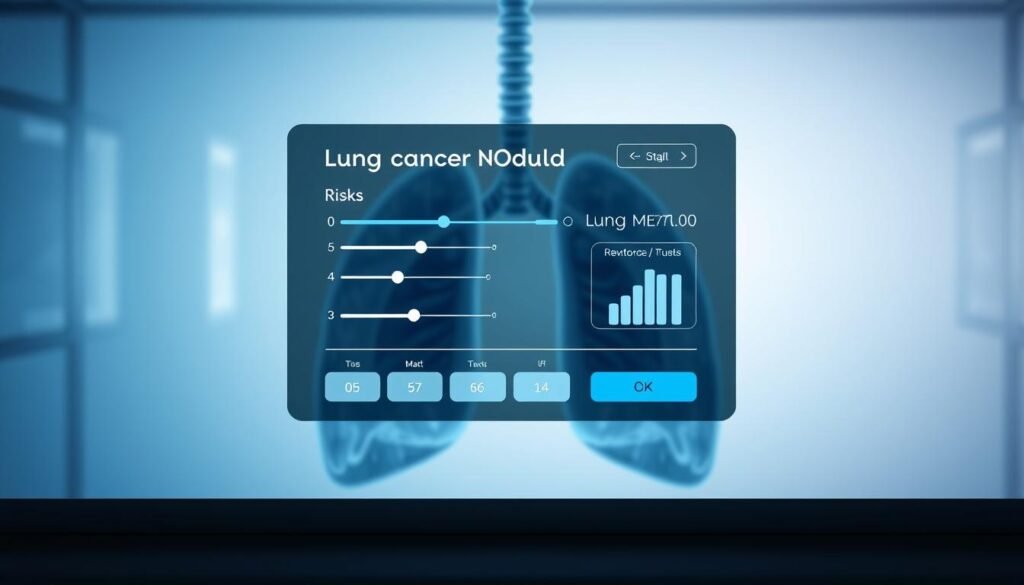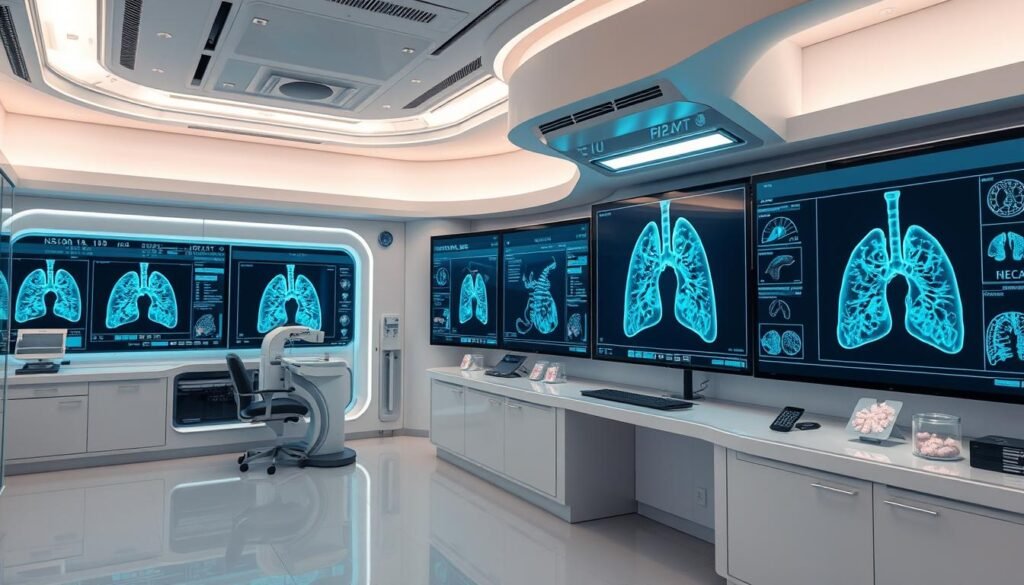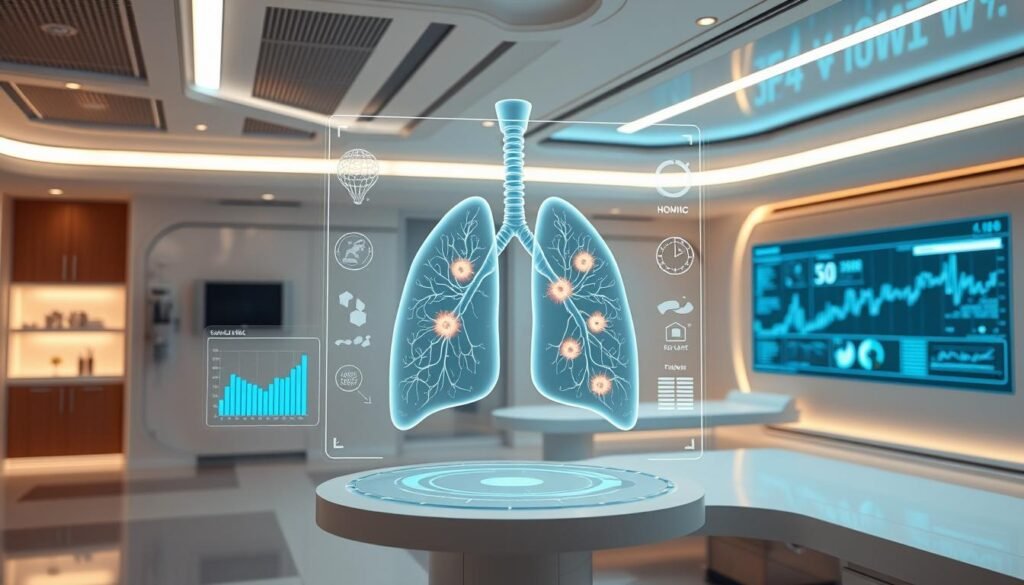Each year, about 1.6 million pulmonary nodules are found in the United States. This large number shows how important lung cancer nodule risk calculators are. They help doctors figure out the risk of cancer in lung nodules. This leads to better decisions early on.
These calculators consider things like age, gender, and the size of the nodule. With this information, doctors can decide on the best screening and treatment plans. As lung cancer becomes more common, knowing how to use these tools can really help patients. It means getting the right treatment early.
This guide will explain how lung cancer screening works and why checking nodules is key. It breaks down complex risk prediction models, highlighting the importance of personal risk analysis. The goal is to help people understand how to deal with lung cancer diagnosis and care.
Key Takeaways
- A staggering 1.6 million pulmonary nodules are detected annually in the U.S.
- Lung cancer nodule risk calculators support early detection and decision-making.
- Key factors for risk assessment include age, gender, and nodule characteristics.
- Different models, such as the Brock and Herder, offer varied predictions for malignancy.
- Understanding these tools is vital for effective lung cancer management and treatment.
Understanding Lung Nodules
Lung nodules are small tissue masses in the lungs, often found during imaging tests. They range in size and may be benign or malignant. It’s key to know about lung nodules for the right diagnosis and treatment. They are looked at closely to see if they could be lung cancer.
What are Lung Nodules?
Lung nodules, or pulmonary nodules, are seen as round or oval shapes. While many are harmless, some could mean lung cancer. Their size, how fast they grow, and your health history help judge their cancer risk.
Types of Lung Nodules
There are different lung nodules, each meaning something for your health. Knowing the type helps in managing them right. Here’s a look at common types:
| Nodule Type | Description | Malignancy Risk |
|---|---|---|
| Solid Nodules | Completely solid, typically requiring more comprehensive imaging | Higher risk of malignancy, especially if larger than 3 cm |
| Semi-Solid Nodules | Partially solid with some liquid components | Moderate risk; depends on specific characteristics |
| Ground-Glass Opacities | Appearance more hazy than solid; may indicate inflammation or early malignancy | Variable risk, assessed based on size and duration |
Importance of Lung Cancer Screening
Lung cancer screening is key for finding lung problems early. It greatly helps patients get better treatment results. Most people with lung cancer, about 80%, die within five years after finding out they have it. This shows how vital early lung cancer detection is. By following screening advice, doctors can find those at high risk sooner. This allows for quick help.
Why Regular Screening is Essential
Regular checks can save many lives from lung cancer. Annual tests with low-dose CT scans find cancer early in 3.9% of those at high risk. Without these tests, fewer people, about 3.2%, would know they have lung cancer. Catching it early means doctors can treat it better. Studies show this could lower deaths from lung cancer by 20%.
Screening Guidelines in the United States
The screening guidelines suggest yearly low-dose CT scans for certain people. This includes smokers and those with lung cancer in their family. It’s important to know that Medicare stops paying for these screenings when you turn 78. This means older people might have to pay themselves. Knowing these rules helps those at risk make smart health decisions.
What is a Lung Cancer Nodule Risk Calculator?
The lung cancer nodule risk calculator is a key tool in cancer care. It estimates if a lung nodule might be cancer. This is done by looking at factors like age, nodule size, family history, and smoking status. It helps doctors plan the best care for their patients.
Definition and Purpose
A lung cancer nodule risk calculator helps clinicians understand the risk of lung nodules. It was created during the Pan-Canadian Early Detection of Lung Cancer Study in 2014. The tool is highly accurate and has the backing of major medical groups. It predicts the cancer risk of lung nodules within 2 to 4 years.
How it Assists in Medical Decision-Making
This calculator makes medical decisions easier by giving detailed information. It considers patient and nodule details, such as age, gender, and nodule size. The calculator also looks at PET-CT scans. This helps doctors personalize care for each patient.
How the Lung Cancer Nodule Risk Calculator Works
The lung cancer nodule risk calculator helps doctors gauge the malignancy risk in lung nodules. It uses critical data and a step-by-step method for accurate results. Knowing how it works helps doctors care for their patients better.
Input Parameters for Calculation
Key input parameters are crucial for this tool. These include:
- Age of the patient
- Gender
- Family history of lung cancer
- Nodule characteristics, such as size, type, and spiculation
Gathering detailed data on these factors is key to getting reliable risk assessments.
Calculation Process Explained
The calculation process uses complex equations. These equations look at the data to figure out if nodules might become cancerous in two to four years. A good methodology lets doctors accurately determine lung cancer risks. Accurate results depend on precise and complete data, highlighting the need for careful data collection.

Nodule Risk Assessment
Evaluating the possibility of lung nodules being cancerous is key. Numerous factors affecting risk are considered in this process. These factors range from patient demographics and history to characteristics of the nodules such as their size and shape. Knowing these details helps doctors gauge the cancer risk of nodules.
Factors Affecting Risk Assessment
Doctors look at several factors affecting risk when assessing nodules. They include:
- Patient Factors: Age, smoking history, and family health history are significant.
- Nodule Characteristics: The size, shape, and growth rate of nodules are crucial.
- Imaging Results: CT scans and PET scans offer deep insights into a nodule’s nature.
- Staging Systems: TNM staging shows cancer’s spread, aiding in treatment decisions.
Using complex models, doctors can estimate lung cancer risk from 4% to 30%. Relying on these models boosts prediction accuracy.
Common Risk Models Used
Different common risk models help predict nodule malignancy. They include:
- Brock Model: It uses clinical and x-ray data to figure out if a nodule could be cancer.
- Herder Model: Known for combining medical and imaging data for better risk calculation.
- PLCOm2012 Model: Provides a six-year cancer risk for smokers, closely matching PLCOall2014 model’s estimates.
- PLCO2012results Model: Merges risk scores with screening results for enhanced accuracy.
Studies validate that these models show malignancy odds from 5% to 65%. Selecting the right model for each patient is crucial. These common risk models help doctors better assess and manage patients’ lung cancer risk. For in-depth guidelines and assessment tools, visit Cancer Research UK. Also, TNM staging offers insight into prognosis; more details at Care Your Lungs.
Nodule Malignancy Prediction Models
Effective models for predicting nodule malignancy are key in evaluating the risk of lung nodules found during screenings. The Brock and Herder models offer different methods and insights. These help doctors in planning how to manage their patients.
Brock Model Overview
The Brock model estimates the chance of a lung nodule being malignant. It considers age, smoking history, features of the nodule, and the patient’s overall health. It uses information from a vast screening group. Its accuracy is impressive, scoring over 0.9 on the AUC ROC scale. It points out patients needing closer monitoring or treatment.
Herder Model Overview
The Herder model includes PET scan results along with common risk factors. It looks at age and smoking history to figure out if a nodule could be cancer. Adding PET-CT scan findings improves the model’s accuracy. This is especially true for unclear nodules.
By using the Herder model and its insights from PET scans, doctors can better plan for their patients’ care in the long run.
Both models show promise in predicting nodule malignancy but need more validation for wider use. A detailed review found many models, but few have been thoroughly checked, especially in Asian populations. There’s a demand for more precise models that cater to different groups. More details on this review can be found here.

| Model Name | Cancer Prevalence | Key Factors Considered | Validation Status |
|---|---|---|---|
| Brock Model | 5.5% | Age, Smoking History, Nodule Characteristics | Limited External Validation |
| Herder Model | 57.5% | Age, Smoking History, Nodule Characteristics, PET Scan Findings | Limited External Validation |
Data-Driven Cancer Care
The way we diagnose lung cancer is changing a lot because of new technology. Using data-driven care makes predictions more accurate and helps doctors make better decisions. This change comes from using machine learning and AI to better assess lung nodules.
Utilization of Machine Learning in Prediction
Machine learning looks at big datasets to help spot patterns that aren’t always obvious. It makes lung cancer risk assessment better by considering things like patient history and stats. For example, tools like the Lung Cancer Screening Implementation Change Package offer key metrics to boost program results.
Thanks to machine learning, doctors can make better guesses about how a disease will progress and what will happen to patients.
Role of AI in Lung Cancer Diagnosis
AI is leading the way in making lung cancer detection and treatment better. It helps read medical images, like CT scans, very accurately. This helps radiologists work faster, leading to quicker diagnoses and care that’s more suited to each patient.
With data-driven cancer care, healthcare workers can customize their methods. This means better survival rates and care quality for those with lung cancer.
Personalized Risk Analysis for Patients
A personalized risk analysis is key in lung cancer care. It lets health workers focus on each patient’s unique needs. By looking at genes, lifestyle, and cancer history, they can make risk assessments more accurate.
Understanding Individual Risk Factors
Many things can affect your risk of getting lung cancer. These include:
- Genetic predisposition: If your family has had it, you might be more likely to get it too.
- Smoking history: Smoking a lot over many years can greatly increase your risk.
- Exposure to environmental pollutants: Being around harmful substances like radon or asbestos can up your risk.
- Age and gender: How common lung cancer is can depend on a person’s age and whether they are male or female.
Benefits of Tailored Risk Assessments
Custom risk assessments have lots of pluses. They make dealing with the disease better. Some top benefits are:
- Informed decision-making: With personalized info, patients can choose their treatment wisely.
- Enhanced monitoring: Doctors can watch a patient’s risk over time. This helps in catching changes early.
- Reduction in unnecessary procedures: Knowing one’s risk can lower stress and avoid unneeded treatments.
| Risk Factor | Impact on Lung Cancer Risk |
|---|---|
| Genetic predisposition | Increases susceptibility based on family history |
| Smoking history | Heightens risk; influence grows with duration and intensity |
| Environmental exposure | Long-term exposure to certain pollutants is linked to higher risk |
| Age and gender | Specific demographic factors can elevate vulnerability |
In the U.S., about 1.6 million lung scans show nodules each year. Personalized risk analysis makes sure everyone gets a customized look at their health. This improves how lung cancer is managed and involves patients more in their care.

Maintaining Effective Lung Nodule Management
Effective management of lung nodules is crucial for good patient outcomes. It requires strong monitoring plans. It also needs following suggestions from healthcare providers tailored to each person’s risk. Regular check-ups help spot changes in nodules that may suggest cancer.
Monitoring Strategies for Lung Nodules
Monitoring lung nodules usually involves:
- Regular imaging follow-ups using low-dose CT scans, particularly for high-risk individuals.
- Biannual assessments based on initial evaluations and risk levels, ensuring proactive management.
- Utilization of classification systems like Lung-RADS to categorize findings and refine monitoring protocols.
- Engaging patients in their health management, promoting awareness and understanding of their specific nodule characteristics.
Most solitary pulmonary nodules (SPNs) are not cancerous. But the chance of cancer varies a lot depending on different factors. Teaching patients about the risks linked with their nodules helps them make informed choices.
Recommendations for Healthcare Providers
Advice from healthcare providers is key in managing lung nodules. They should focus on:
- Employing standardized guidelines from reputable associations like the Fleischner Society.
- Identifying high-risk populations, such as former and current smokers, for more intensive monitoring.
- Encouraging multidisciplinary discussions, involving oncologists, radiologists, and pulmonologists, to create comprehensive management plans.
- Staying current with advancements in monitoring technology and emerging biomarkers that can enhance the evaluation of SPNs for malignancy.
By following these guides and improving how they talk with patients, healthcare workers can manage lung nodules better. Using the right monitoring methods and listening to experts ensures quick actions and better patient health. For more info, see insights from leading experts here.
Conclusion
The lung cancer nodule risk calculator is a key tool in fighting lung cancer. It greatly improves early detection of possible cancers. Using it, doctors can look at a patient’s risk factors and decide on the best care. This leads to better results for patients.
This tool’s role in regular screenings is very important. Every year, about 1.6 million lung nodules are found in the U.S. It’s vital to keep an eye on these nodules. Using models like Herder and Mayo, doctors can accurately predict which nodules might be cancerous. This shows how important data-driven tools are in caring for patients.
These calculators also help doctors and patients work together towards better lung health. More people now understand how serious lung nodules can be. So, there’s a stronger focus on early detection and tailor-made treatment plans. These efforts can make treatments work better and help people live longer.